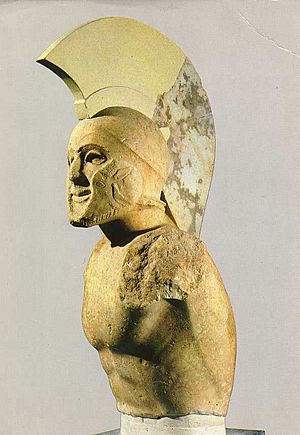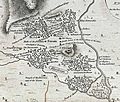Sparta facts for kids
Quick facts for kids
Lacedaemon
Λακεδαίμων (Ancient Greek)
|
|||||||||||
|---|---|---|---|---|---|---|---|---|---|---|---|
| 900s–192 BC | |||||||||||
|
The letter lambda was used by the Spartan army as a symbol of Lacedaemon
|
|||||||||||
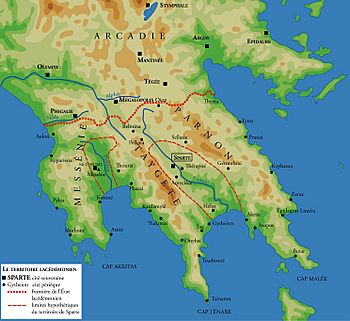
Territory of ancient Sparta
|
|||||||||||
| Capital | Sparta | ||||||||||
| Common languages | Doric Greek | ||||||||||
| Religion | Greek polytheism | ||||||||||
| Government | Diarchy | ||||||||||
| King | |||||||||||
|
• 1104–1066 BC
|
Eurysthenes | ||||||||||
|
• 1104–1062 BC
|
Procles | ||||||||||
|
• 489–480 BC
|
Leonidas I | ||||||||||
| Legislature |
|
||||||||||
| Historical era | Classical antiquity | ||||||||||
|
• Foundation
|
900s BC | ||||||||||
|
• Messenian War
|
685–668 BC | ||||||||||
| 480 BC | |||||||||||
| 431–404 BC | |||||||||||
|
• Battle of Mantinea
|
362 BC | ||||||||||
|
• Annexed by Achaea
|
192 BC | ||||||||||
|
|||||||||||
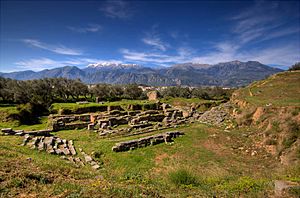
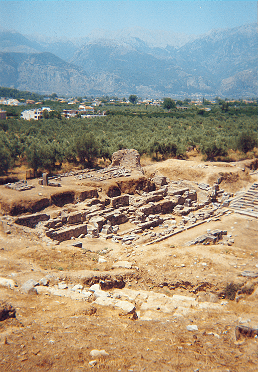
Sparta is a city in Greece. It is the capital of the Laconia prefecture. It is in the south of Peloponnese peninsula. During antiquity, it was extremely powerful. Today, it is a small city. 16,726 people lived there according to the 2001 census. The word Spartan is used to describe somebody who lives a simple life or somebody who suffered a lot without crying or showing that they suffered. It can also mean a life of simplicity, without anything fancy or costly.
Contents
Geography
Sparta is in the mountainous region of Laconia. This is in the south-east of the Peloponnese. Ancient Sparta was built on the banks of the Evrotas River. The river flows through a valley with mountains on each side. To the west is the Taygetus Range (highest point 2407 m) and to the east is the Parnon Range (highest point 1935 m). Because the ancient Spartans had such good natural defenses, they did not need city walls. Sparta was known greatly for their military. They were one of the greatest military powers of their time.
Characteristics
Sparta was a city-state with a very strong army and a government that was well led. Sparta was known as one of the strongest city-states in Greece. Only the strongest survived in Sparta, male or female. The Spartans killed weak children. If they believed that a baby was too weak, they left it out to die of exposure beside a slope on Mount Taygetus. This place was called the Apothetae, which meant 'the place of rejection'.
At its peak around 500 BC, Sparta had some 20,000–35,000 citizens, plus numerous helots and perioikoi. The likely total of 40,000–50,000 made Sparta one of the larger Greek city-states.
Customs
Young Spartans boys were taken from their homes at the age of seven to begin a military life. The Spartans became soldiers at age 20, citizens at age 30, and retired at age 60. Men trained hard to become warriors of the Spartan army. Women were encouraged to keep healthy so that they could produce healthy, fit babies to grow up to be strong. Spartans saw little moral value in the concept of childbirth; unless the child was fit to become a Spartan, he would die.
Government
Sparta had a government with checks and balances. The executive branch was led by two kings. The legislative branch was led by the citizens. and the judicial branch was controlled by the elders. There was also a committee of five men who were in charge of the education process that young boys and girls went through. Boys and girls were taken from their parents at the age of 7. Boys went to live in barracks with other boys their age. Girls went to school to learn gymnastics, wrestling, and other activities.
Laconophilia
Laconophilia is love or liking of Sparta and of the Spartan culture. Sparta was often admired when it ruled. Long ago, "Many of the noblest and best of the Athenians always considered (thought) the Spartan state nearly as an ideal theory realised in practice". Many Greek philosophers, especially Platonists, would often describe Sparta as a good state, strong, brave, and free.
Sparta was also seen as a model of social purity by Revolutionary and Napoleonic France.
Marriage
Spartan men married when they were 30 years old. Plutarch writes of the strange custom of the Spartans for their wedding night:
The custom was to capture women for marriage...The...'bridesmaid' took charge of the captured girl. She first shaved her head...then dressed her in a man's cloak and sandals, and laid her down alone on a mattress in the dark. The bridegroom...first had dinner...then would slip in...lift her and carry her to the bed.
The husband kept on visiting his wife in secret for some time after the marriage. Only Spartans did these customs. Some people think that the cutting off of the wife's hair was a ceremony that showed she was going into a new life.
History
Sparta conquered the people of Messenia and Lakonia (the surrounding countryside) at around 680–560 BC. These people became known as the helots. They were not slaves: they were serfs. They had a lower position in society, like serfs in mediaeval Europe.
Helots spent their lives farming their Spartan masters kleros (land granted to Spartan citizens). The Spartan poet Tyrtaios says helots were allowed to marry and keep half the fruits of their labor. At most times, the helots outnumbered their Spartan masters 10 to 1. They rebelled often, but they were never able to overthrow their oppressors.
Once a Spartan reached the age of 20, he or she would then become a homoios. A homoios was a member of the ruling class (a citizen). Both men and women were citizens. Sparta was an unusual society for women's rights, because women were considered to be equal. The Spartan army used a formation called the phalanx. This contributed to the many battles Sparta won.
Images for kids
-
Hollow Lacedaemon. Site of the Menelaion, the ancient shrine to Helen and Menelaus constructed in the Bronze Age city that stood on the hill of Therapne on the left bank of the Eurotas River overlooking the future site of Dorian Sparta. Across the valley the successive ridges of Mount Taygetus are in evidence.
-
Name vase of the Spartan artist known as the Rider Painter (Laconian black-figured kylix, c. 550–530 BC)
-
Jean-Pierre Saint-Ours, The Selection of Children in Sparta, 1785. A Neoclassical imaging of what Plutarch describes.
See also
 In Spanish: Esparta para niños
In Spanish: Esparta para niños



